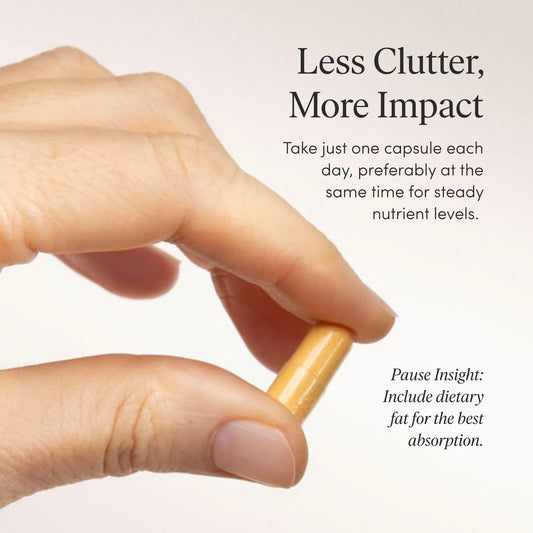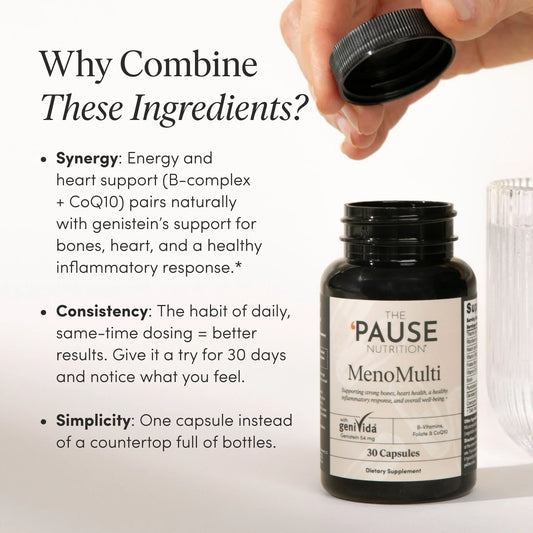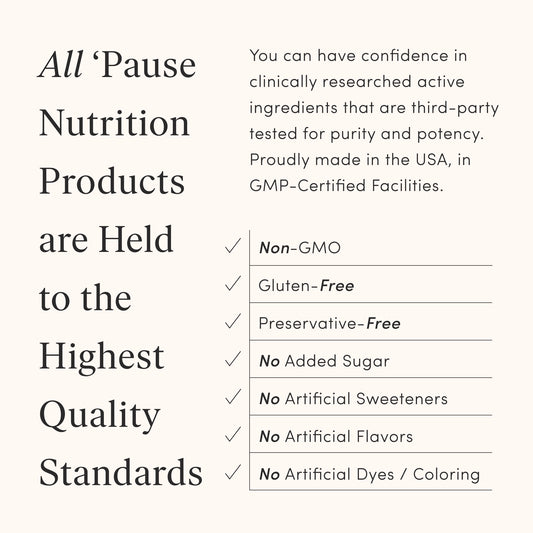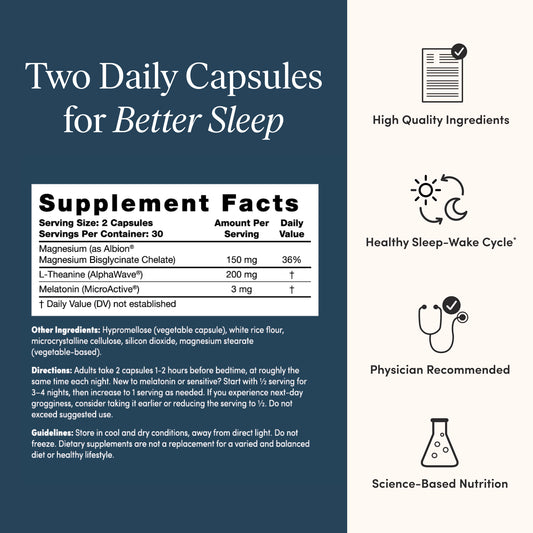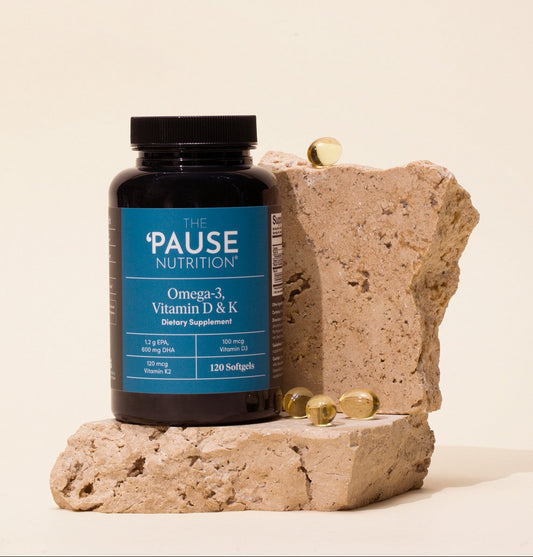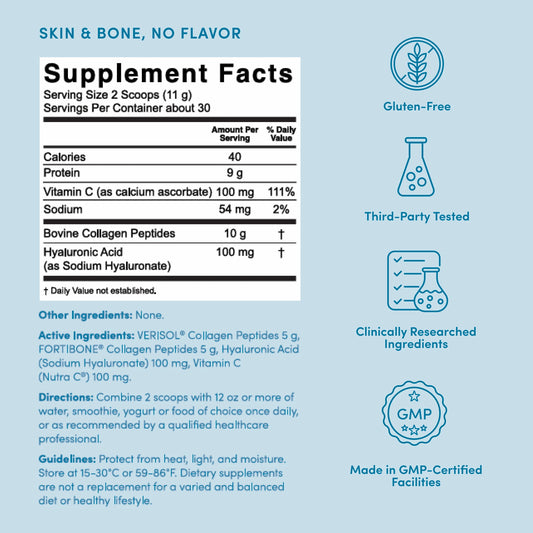Hot or Hype: The Science Behind Testosterone and Other Treatments for Low Sex Drive in Women

Share
As a board-certified OBGYN and National Certified Menopause Specialist, I've seen firsthand how the decline in hormones during menopause can significantly impact a woman's quality of life. One hormone often overlooked in this discussion is testosterone. While it's often associated with men, testosterone plays a vital role in women's health as well.
Given the significant impact of testosterone on women's health, it's crucial to examine the evidence supporting its use in menopause. Let's dive into the world of hormone replacement therapy (HRT) to understand how it addresses the decline in testosterone and other hormones.
What is hormone replacement therapy?
Hormone replacement therapy (HRT), often referred to as menopause hormone therapy (MHT), is a medical treatment primarily used to relieve symptoms of menopause in women.(1) As we approach menopause, the natural decline in estrogen, progesterone, and testosterone can lead to symptoms such as hot flashes, night sweats, mood changes, muscle and joint pain, brain fog, vaginal dryness, and low libido. For many women, these symptoms can severely affect their quality of life.
As a physician, I want to emphasize that hormone therapy works by replenishing the estrogen, progesterone, and testosterone levels that your body is no longer producing in sufficient amounts to promote health. The goal is to alleviate symptoms by restoring health-promoting hormone levels. Still, MHT also has additional benefits, like maintaining bone density, which reduces the risk of osteoporosis—a concern for postmenopausal women.
What are the benefits/risks?
It is important to note that hormone therapy is not a one-size-fits-all solution. (2) There are risks associated with it, especially if taken inappropriately. Studies have shown that certain types of estrogen-containing hormone therapy can increase the risk of certain conditions, such as blood clots and stroke. Testosterone therapy can increase the risk of unwanted hair growth, deepening of the voice, and acne. Still, these risks can vary based on factors like the type of hormones used, the dosage, the delivery system (i.e., oral versus non-oral), and how long the therapy is continued. Every woman's situation is unique, and we need to balance the potential benefits against the risks with the proper dosage, formulations, and delivery system.
For women who are within ten years of menopause onset and under 60, MHT can be an effective and safe option to consider, particularly for those suffering from moderate to severe symptoms of menopause. It’s always essential to have a thorough discussion with your healthcare provider to assess your specific health profile and determine the best course of action.
Understanding Female Sexual Dysfunction
Before we dive into the role of testosterone and its role in female sexual desire, it’s crucial to understand that low sex drive in women can be a complex issue. Female sexual dysfunction is a medical condition that can interfere with a woman's enjoyment of sex. (3) It’s important to note that this is considered a dysfunction only if it causes significant distress or discomfort. If the lack of sexual function is bothering you, then read on and have this meaningful conversation with your healthcare provider.
Types of Female Sexual Dysfunction
The way I see it, there are five conditions leading to female sexual dysfunction:
- Relationship Disorder: I list this first because if this is the underlying issue, then no medication, miracle pill, patch, or cure is going to fix this outside of treatment with counseling and therapy.
- Desire Disorder: Difficulty experiencing or maintaining sexual desire. This is thought to come from a problem where the brain doesn’t respond to a stimulus.
- Arousal Disorder: Difficulty achieving or maintaining sexual arousal. This is when your pelvis doesn’t respond correctly to a stimulus - for example, unable to achieve adequate blood flow to the pelvic organs.
- Orgasmic Disorder: Difficulty experiencing or achieving orgasm.
- Pain Disorder: Pain during or after sexual intercourse. If sex is painful, this can be due to vaginal atrophy due to low estrogen levels in perimenopause and menopause. The treatment here is vaginal estrogen. If it hurts when you have sex, then it makes sense to fix that pain first before trying to address other disorders. If this is you, please make an appointment and talk to your healthcare professional.
Addressing Desire Disorder: The Role of Testosterone
The official term for desire disorder (low libido) is Hypoactive Sexual Desire Disorder (HSDD). (4)
Testosterone, often thought of as a "male hormone," actually plays a significant role in women's health as well, particularly when it comes to sexual desire. (5) While women have much lower levels of testosterone compared to men, this hormone has a significant impact. It plays a crucial role in various aspects of women's health, including:
- Libido: Testosterone helps regulate sexual desire and arousal.
- Energy levels: It can contribute to feelings of vitality and motivation.
- Mood: Testosterone can influence mood and overall well-being.
Physiologically, testosterone in women is produced primarily by the ovaries and adrenal glands. When testosterone levels decline—something that can happen as women age, especially around the time of menopause—it can lead to a decrease in sexual desire, arousal, and satisfaction.
Here's how it works: Testosterone acts on some regions of the brain, such as the hypothalamus and the amygdala, which are critical regions involved in regulating sexual behavior. By increasing testosterone levels, these brain centers become more responsive to sexual stimuli, which can lead to an increase in libido.
Testosterone Therapy: Benefits and Considerations
For women experiencing low libido, especially around menopause when hormone levels fluctuate, testosterone therapy may be considered as part of a broader treatment plan. The goal is to restore levels to the normal physiological range for women, improving sexual desire without pushing the body into a "male" hormone profile. Studies have shown that for some women, boosting testosterone levels can lead to noticeable improvements in sexual desire, frequency of sexual thoughts, and overall sexual satisfaction. (6)
Testosterone is a hormone that has been studied in the treatment of low libido (HSDD) in women. While its effectiveness in premenopausal women is still being investigated, it has shown promising results in menopausal women.
- How to take it? I wish I had a short answer for you. Unfortunately, this is the complicated part. There isn’t an FDA-approved form of testosterone that is made just for women. So that means we have to work with what is out there.
Types of Testosterone Therapy That Are Out There
- Topical Compounded Testosterone: This is the most common and convenient form of testosterone therapy for women. It's applied daily to the skin as a cream, ointment, or gel. However, compounded testosterone products are not regulated by the FDA, which can raise concerns about quality and consistency. There is a reputable professional guideline that says women should avoid using compounded testosterone unless there are no other approved options. (7) Guess what? In the US, there are no FDA-approved testosterone options for women. Is this the time to mention that there are over 30 approved testosterone products for men? (8) (Excuse me while I go and scream into the void; be right back.)
- Male Testosterone Patch or Gel: Speaking of all those FDA-approved testosterone products for men, these are those products that are designed for men but can be used in women with careful dose adjustment. However, they may need to be more accurate and convenient for women. Women should use about 1/10th the dose men use, but this can be hard with the gels currently available for men. Also, the FDA has warned that testosterone gels can be harmful to children if they touch the skin of an adult who has recently used it. To minimize this risk, always wash your hands and cover the area where you applied the product with clothing.
- Injectable or Implantable “Pellet” Preparations: These options are not recommended for women due to discomfort, inconvenience, and difficulty adjusting dosage. Dosing with these often leads to testosterone levels that are superphysiologic - higher than an average healthy woman would ever experience naturally.
Testosterone Dosage and Monitoring
- How much? The dose must be individualized. You must work with a knowledgeable healthcare professional to find what will work for you. Based on studies in postmenopausal women with HSDD, the starting dose of testosterone gel was 5 mg/day (0.5 ml), which is 1/10th the starting dose used in men. Small increases can be made up to 10 mg/day (1.0 ml) if needed. (9)
- What do I need to get checked? Baseline testosterone level, lipid panel, and liver function tests should be monitored at least yearly during testosterone therapy.
- How long until it kicks in? Clinical benefits may be seen within 6-8 weeks, but maximum results can take up to 12 weeks. If you don’t notice a benefit after six months, you should stop using it.
- What are the risks? Potential side effects include acne, deepening of the voice, alopecia, changes in lipid profile, and abnormal hair growth. However, testosterone may also have protective effects against breast cancer.
- Wash those hands! Don’t forget to cover the area and wash your hands after applying testosterone products to your skin.
However, it's important to note:
- Individual variation: The effectiveness of testosterone therapy can vary significantly from woman to woman. Work with your healthcare provider to find out what works for you.
- Not FDA-approved: Testosterone therapy is not specifically FDA-approved for women in the U.S. It's used off-label, making it crucial to consult with a knowledgeable healthcare provider. (10)
Beyond Testosterone: Other Approaches to Boosting Libido
While MHT, specifically testosterone therapy, can be beneficial for some women, it's not the only option for addressing low libido. Other non-hormonal approaches may include:
- Lifestyle changes: Regular exercise, a healthy diet, and stress management can positively impact sexual desire.
- Medications: Certain medications, such as Addyi and Vyleesi, are specifically designed to treat low sexual desire in women. I’ll go into more detail on these below.
- Counseling: Addressing underlying psychological factors, such as relationship issues or stress, can also help improve libido.
Two FDA-approved medications—Addyi (flibanserin) and Vyleesi (bremelanotide)—have been developed specifically to address low sexual desire in women.
- Addyi works on the brain, targeting neurotransmitters involved in regulating mood and sexual desire. (11) To get technical, it works by decreasing serotonin and increasing dopamine and norepinephrine in certain brain sections.
- How to take it? It is taken daily by mouth before bed. You can’t take this with alcohol. You need to make sure you have at least 2 hours between your last drink and taking this medication.
- What is it for? It is FDA-approved for premenopausal women with Hypoactive Sexual Desire Disorder (HSDD).
- How well did it work? Studies have shown that Addyi can help women with low sexual desire have slightly more satisfying sexual experiences each month. (2)
- Like, really, what did it do? In the studies, women taking Addyi daily had an average of 2 to 3 satisfying sexual events per month before starting flibanserin. After taking flibanserin, some women reported up to 1 more additional satisfying sexual event per month.(12)
- What are the risks? Include dizziness, drowsiness, and fatigue. If you have more than two alcoholic drinks, hold your dose for that day.
- How long before it kicks in? Some people notice changes in sexual thoughts and interest increasing in as little as four weeks, but you should give it at least two months to feel the full effects.
- Fun fact: Addyi was initially studied as a potent antidepressant, but it wasn’t working to help people feel less depressed. Instead, it ended up giving them a boost in their sex life! (13)
- Vyleesi is another FDA-approved medication designed to treat low sexual desire in women who have not gone through menopause. (14) They aren’t exactly sure how Vyleesi works, but they do know it mimics certain neurotransmitters, and this is thought to help with arousal and sexual desire.
- How to take it? Vyleesi is injected subcutaneously (under the skin) once daily, approximately 45 minutes before sexual activity.
- What did the studies show? Studies have shown that Vyleesi can increase sexual desire and satisfaction in women with HSDD. (15) In clinical trials, a higher percentage of women treated with Vyleesi experienced a meaningful increase in sexual desire and improvement in sexual satisfaction compared to those who didn’t take it. But this didn’t translate to more satisfying sexual experiences each month. (16)
- How long before it kicks in? It starts working in about 45 minutes and lasts up to about 16 hours. But you can’t use it more than once every 24 hours.
- Who shouldn’t use it? If your blood pressure is not controlled or you have heart disease, this drug is not for you.
- What are the risks? Nausea can be intense with the first dose. So watch out for nausea, vomiting, flushing, and headaches. There have even been some rare reports of hyperpigmentation. That’s when you have darkening of the skin or gums, especially on the face or breasts.
- What is special about it? One of Vyleesi's unique features is its on-demand use. This means it's taken only when you anticipate sexual activity, making it a flexible option for women who don't experience low libido consistently or prefer to avoid daily medication.
Challenging Common Misconceptions About Female Sexual Dysfunction
Now, when it comes to advice that many women receive from well-meaning but often untrained healthcare providers, the problem is that female sexual function is complex. It’s not simply a matter of "relaxing" or "spicing things up." Statements like “Have a date night, drink some wine, or just take one for the team” oversimplify what is often a multifaceted issue. These suggestions can minimize the fundamental physiological and psychological factors at play and, worse, can make women feel that their lack of desire is somehow their fault or not valid.
Many doctors never received formal training in female sexual health during their medical education, especially when it comes to libido and arousal. As a result, women can often feel dismissed or not fully supported when discussing sexual health concerns. The truth is that sexual function in women can be influenced by hormones, neurotransmitters, mental health, relationship dynamics, and even chronic medical conditions. Effective treatment involves addressing these root causes, not offering superficial fixes.
Women need to know that low libido (HSDD) is a legitimate medical concern, not just something they have to “push through.” Proper medical evaluation, including hormone levels, psychological health, and tailored treatments like Addyi, Vyleesi, or even counseling with a sexual health expert, can lead to real improvements in sexual desire and overall well-being. The key is getting the proper support and avoiding the dismissive advice that too many women have heard.
Remember, every woman's experience is unique. If you're struggling with low libido or other menopausal symptoms, it's essential to consult with a healthcare provider to discuss your options and determine the best approach for you.


















